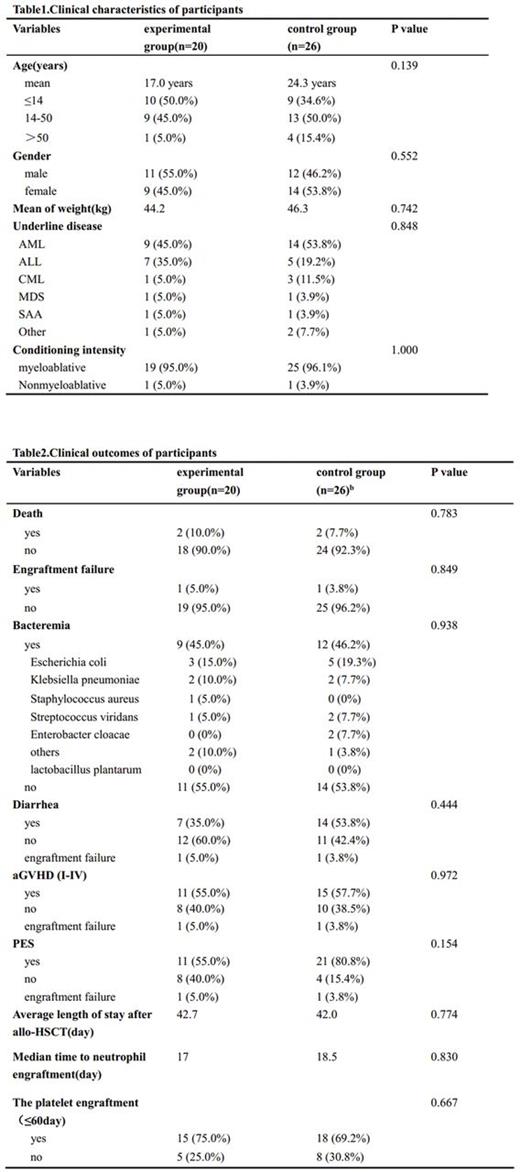Abstract
Background: During last few years, intestinal microbiota, as a vital biological regulatory substance after hematopoietic stem cell transplantation (HSCT), has been attached with growing importance. Probiotics in yogurt may have positive effect in protecting intestinal microbiota diversity and improving the prognosis of patients after HSCT. However, the safety of supplement yogurt has not been evaluated in the early phase of HSCT. In order to evaluate the safety and feasibility of yogurt, we conducted a pilot study in patients who had undergone unrelated cord blood transplantation (UCBT).
Method: Between February and June 2017, patients receiving UCBT was divided into two groups randomly. The experimental group (20 patients; mean age 17y, r 1-59; male 11) and control group (26 patients; mean age 24.3y, r 1-59; male 12) have no significant differences in age, gender, weight, underlying diseases and conditioning intensity (Table 1). Patients in experimental group (n=20) take in 200ml yogurt while children take in 100ml every day on day -7 and continue until day +30 (xinxiwang yogurt, including lactobacillus bulgaricus, streptococcus thermophilus, lactobacillus plantarum, lactobacillus rhamnosus, the number of lactobacillus≥108CFU/100g, produced at Jinrong Road 33rd, Shuangfeng economic industrial zone, Changfeng, Hefei, Anhui), while patients in control group (n=26) taking in nothing. All patients received CsA plus mycophenolate mofetil as GVHD prophylaxis.
Results: we compared some indicators related to UCBT between the two group (Table 2). The primary engraftment rate is 95.0% (experimental group) and 96.2% (control group). The mortality in 60 day is 10% and 7.7% and the median time to 0.5×109/L ANC was 17 days (r 12-30) and 18.5 days(r 12-24). The incidence of acute GVHD gradeⅠ-Ⅳ (55.0% vs.57.7%, P= 0.972), bacteremia (45.0% vs.46.2%, P= 0.972), diarrhea (35.0% vs.53.8%, P= 0.444), and pre-engraftment syndrome (55.0% vs.80.8%, P= 0.154) show no significant differences between two group. While, the continuous change of CRP ( P= 0.343), weight( P= 0.738), and albumin( P= 0.345) from day -7 to day +30 is also no significant difference between two groups. We don't observe any case of lactobacillus bacteremia (0%) in experimental group, together with none occurrence of lactobacillus-related unexpected adverse events through the whole study.
Conclusion: Our data show it is safe and feasible to supplement yogurt during early phase of unrelated cord blood transplantation. It will not result in an increasing related risks including infection, diarrhea, aGVHD, and also not influence the nutritional status of patients. However, due to the limitation of the number of cases and short observation duration, we can not evaluate the effectiveness of the supplement yogurt. Further conclusion requires larger sample size and longer observation duration.
No conflict of interest to declare.
No relevant conflicts of interest to declare.
Author notes
Asterisk with author names denotes non-ASH members.


This feature is available to Subscribers Only
Sign In or Create an Account Close Modal